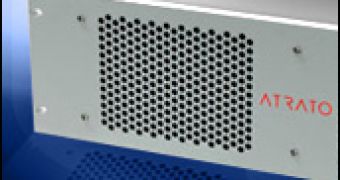The world of data storage has been enriched with Atrato's Velocity1000, a high-performance storage system. The V1000 is able to provide up to 50 terabytes of storage and it can handle up to 11,000 input/output operations per second (IOPS). The performance of the system might be even more impressive than that as, according to Henry Baltazar, a storage analyst with The 451 Group, V1000 handles the I/Os from its disks.
Velocity1000 is based on a SAID system (Self-maintaining Array of Identical Disks). There are 100 to 200 2.5" hard drives stuck together into the chassis. The difference between this storage system and the conventional arrays is that V1000 handles the data directly from its disks at impressive speeds, while other systems feature high speeds only for data stored in cache. This way, the Self-maintaining Array of Identical Disks allows the storage system to give more performance than conventional ones. Also, the chassis may be adjusted for more speed or to fit more storage.
Companies that have large stores of data face quite a problem when it comes to access. According to Baltazar, Velocity 1000 solves this problem. "It's hard to give random access to that data when you have thousands of people trying to get at that stream" all at once. "If you can cache the data set, hundreds of thousands of I/Os are not out of line," Baltazar said. "But if 3,000 people want to watch Lost at the same time, that's a very different problem." Atrato's storage system seems to be the solution for this issue.
"IT managers assume that by adding rack units, they will get the increased IOPS needed," noted Dan McCormick, co-founder and CEO of Atrato. According to the company, the SAID architecture is the most effective solution for IT managers. It can offer both the high-volume storage capacity and the performance rate needed for thousands of simultaneous users. "The reality is that over-allocating not only fails to deliver the expected performance gains, but also adds costly power- and space-intensive overhead to the data center," he added.
Atrato claims that the Velocity 1000 storage system doesn't require any maintenance for three to five years. The errors that occur are said to be remedied on-the-fly. The system is capable of detecting those errors and of avoiding disk areas that have failed, maintaining a smooth data flow all the time. The system self-heals itself and there will be no need for the canisters to be opened for at least five years.
Probably, the company will not try to get its V1000 to be used for typical enterprise applications like working with Oracle or archiving e-mails. Baltazar said that, in his opinion, Atrato will try to go vertical with this. He also said that the system lacks some key components that allow it to be used for those enterprise applications.
The competition Atrato has to face on the storage systems market is a strong one. Companies like IBM, EMC, Network Appliance and Dell are already there and Atrato would need a major storage vendor as its partner to have a better chance for success, according to Baltazar. Although the company has just counted $18 million in venture capital, it needs big money for marketing and sales. It still has to prove to customers that its SAID architecture is reliable and cost-effective.
Atrato already announced on Tuesday that the company was working together with SRC Computers on a partnership for finding a solution to integrate the Velocity1000 storage system into high-performance computing environments. Yet, there is still hard work for the company to do. As Baltazar said, "They've got to go out there and get those partnership relationships forged."
Depending on configuration, the prices for the Velocity1000 storage server rise above six figures, although the company hasn't given an exact sum to the press. Yet, the storage system will be less expensive than the enterprise quality SSDs.

 14 DAY TRIAL //
14 DAY TRIAL //